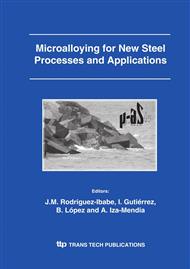p.711
p.719
p.729
p.737
p.745
p.753
p.761
p.771
p.779
Optimisation of V/N Ratios and Stelmor Cooling for Electric Arc Furnace Steels Used in Galvanised High Tensile Strength Wire Applications
Abstract:
The high level of residual nitrogen in Electric Arc Furnace (EAF) steels is one of the major factors influencing the performance of the finished product. For high tensile strength galvanised wire applications, nitrogen in interstitial solid solution can severely limit drawability and formability. This problem can be controlled simply and effectively by adding nitride-forming elements to the molten steel so that the nitrogen is removed from solution. Vanadium additions are especially beneficial in high strength steels because the removal of nitrogen as vanadium-nitride can cause extensive precipitation strengthening. This investigation concerns commercial grade steels microalloyed with vanadium and rolled to 5.5mm rod, under controlled Stelmor cooling conditions. This rod is used to produce 2.5mm high tensile strength galvanised wire. The aim of the research was to determine the optimum vanadium/nitrogen (V/N) ratio and Stelmor cooling profile for the vanadium steel rod. This was achieved by extensive production and laboratory trials followed by mechanical and microstructural analyses of the product.
Info:
Periodical:
Pages:
745-752
Citation:
Online since:
November 2005
Authors:
Keywords:
Price:
Сopyright:
© 2005 Trans Tech Publications Ltd. All Rights Reserved
Share:
Citation:


